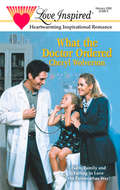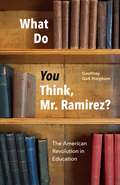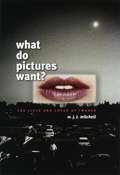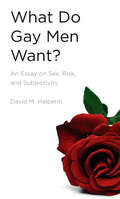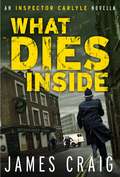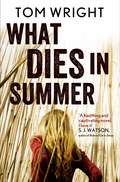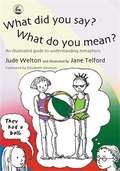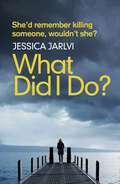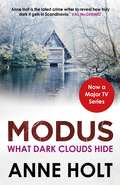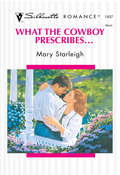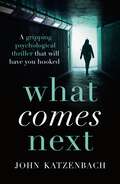- Table View
- List View
What The Doctor Ordered (Fairweather #1)
by Cheryl WolvertonCome and meet the folks of Fairweather, Minnesota, the small town with the big heart that you'll want to return to again and again!
What Do You Think, Mr. Ramirez?: The American Revolution in Education
by Geoffrey Galt HarphamGeoffrey Galt Harpham’s book takes its title from a telling anecdote. A few years ago Harpham met a Cuban immigrant on a college campus, who told of arriving, penniless and undocumented, in the 1960s and eventually earning a GED and making his way to a community college. In a literature course one day, the professor asked him, “Mr. Ramirez, what do you think?” The question, said Ramirez, changed his life because “it was the first time anyone had asked me that.” Realizing that his opinion had value set him on a course that led to his becoming a distinguished professor. That, says Harpham, was the midcentury promise of American education, the deep current of commitment and aspiration that undergirded the educational system that was built in the postwar years, and is under extended assault today. The United States was founded, he argues, on the idea that interpreting its foundational documents was the highest calling of opinion, and for a brief moment at midcentury, the country turned to English teachers as the people best positioned to train students to thrive as interpreters—which is to say as citizens of a democracy. Tracing the roots of that belief in the humanities through American history, Harpham builds a strong case that, even in very different contemporary circumstances, the emphasis on social and cultural knowledge that animated the midcentury university is a resource that we can, and should, draw on today.
What Do You Think, Mr. Ramirez?: The American Revolution in Education
by Geoffrey Galt HarphamGeoffrey Galt Harpham’s book takes its title from a telling anecdote. A few years ago Harpham met a Cuban immigrant on a college campus, who told of arriving, penniless and undocumented, in the 1960s and eventually earning a GED and making his way to a community college. In a literature course one day, the professor asked him, “Mr. Ramirez, what do you think?” The question, said Ramirez, changed his life because “it was the first time anyone had asked me that.” Realizing that his opinion had value set him on a course that led to his becoming a distinguished professor. That, says Harpham, was the midcentury promise of American education, the deep current of commitment and aspiration that undergirded the educational system that was built in the postwar years, and is under extended assault today. The United States was founded, he argues, on the idea that interpreting its foundational documents was the highest calling of opinion, and for a brief moment at midcentury, the country turned to English teachers as the people best positioned to train students to thrive as interpreters—which is to say as citizens of a democracy. Tracing the roots of that belief in the humanities through American history, Harpham builds a strong case that, even in very different contemporary circumstances, the emphasis on social and cultural knowledge that animated the midcentury university is a resource that we can, and should, draw on today.
What Do You Think, Mr. Ramirez?: The American Revolution in Education
by Geoffrey Galt HarphamGeoffrey Galt Harpham’s book takes its title from a telling anecdote. A few years ago Harpham met a Cuban immigrant on a college campus, who told of arriving, penniless and undocumented, in the 1960s and eventually earning a GED and making his way to a community college. In a literature course one day, the professor asked him, “Mr. Ramirez, what do you think?” The question, said Ramirez, changed his life because “it was the first time anyone had asked me that.” Realizing that his opinion had value set him on a course that led to his becoming a distinguished professor. That, says Harpham, was the midcentury promise of American education, the deep current of commitment and aspiration that undergirded the educational system that was built in the postwar years, and is under extended assault today. The United States was founded, he argues, on the idea that interpreting its foundational documents was the highest calling of opinion, and for a brief moment at midcentury, the country turned to English teachers as the people best positioned to train students to thrive as interpreters—which is to say as citizens of a democracy. Tracing the roots of that belief in the humanities through American history, Harpham builds a strong case that, even in very different contemporary circumstances, the emphasis on social and cultural knowledge that animated the midcentury university is a resource that we can, and should, draw on today.
What Do You Think, Mr. Ramirez?: The American Revolution in Education
by Geoffrey Galt HarphamGeoffrey Galt Harpham’s book takes its title from a telling anecdote. A few years ago Harpham met a Cuban immigrant on a college campus, who told of arriving, penniless and undocumented, in the 1960s and eventually earning a GED and making his way to a community college. In a literature course one day, the professor asked him, “Mr. Ramirez, what do you think?” The question, said Ramirez, changed his life because “it was the first time anyone had asked me that.” Realizing that his opinion had value set him on a course that led to his becoming a distinguished professor. That, says Harpham, was the midcentury promise of American education, the deep current of commitment and aspiration that undergirded the educational system that was built in the postwar years, and is under extended assault today. The United States was founded, he argues, on the idea that interpreting its foundational documents was the highest calling of opinion, and for a brief moment at midcentury, the country turned to English teachers as the people best positioned to train students to thrive as interpreters—which is to say as citizens of a democracy. Tracing the roots of that belief in the humanities through American history, Harpham builds a strong case that, even in very different contemporary circumstances, the emphasis on social and cultural knowledge that animated the midcentury university is a resource that we can, and should, draw on today.
What Do You Think, Mr. Ramirez?: The American Revolution in Education
by Geoffrey Galt HarphamGeoffrey Galt Harpham’s book takes its title from a telling anecdote. A few years ago Harpham met a Cuban immigrant on a college campus, who told of arriving, penniless and undocumented, in the 1960s and eventually earning a GED and making his way to a community college. In a literature course one day, the professor asked him, “Mr. Ramirez, what do you think?” The question, said Ramirez, changed his life because “it was the first time anyone had asked me that.” Realizing that his opinion had value set him on a course that led to his becoming a distinguished professor. That, says Harpham, was the midcentury promise of American education, the deep current of commitment and aspiration that undergirded the educational system that was built in the postwar years, and is under extended assault today. The United States was founded, he argues, on the idea that interpreting its foundational documents was the highest calling of opinion, and for a brief moment at midcentury, the country turned to English teachers as the people best positioned to train students to thrive as interpreters—which is to say as citizens of a democracy. Tracing the roots of that belief in the humanities through American history, Harpham builds a strong case that, even in very different contemporary circumstances, the emphasis on social and cultural knowledge that animated the midcentury university is a resource that we can, and should, draw on today.
What Do You Think, Mr. Ramirez?: The American Revolution in Education
by Geoffrey Galt HarphamGeoffrey Galt Harpham’s book takes its title from a telling anecdote. A few years ago Harpham met a Cuban immigrant on a college campus, who told of arriving, penniless and undocumented, in the 1960s and eventually earning a GED and making his way to a community college. In a literature course one day, the professor asked him, “Mr. Ramirez, what do you think?” The question, said Ramirez, changed his life because “it was the first time anyone had asked me that.” Realizing that his opinion had value set him on a course that led to his becoming a distinguished professor. That, says Harpham, was the midcentury promise of American education, the deep current of commitment and aspiration that undergirded the educational system that was built in the postwar years, and is under extended assault today. The United States was founded, he argues, on the idea that interpreting its foundational documents was the highest calling of opinion, and for a brief moment at midcentury, the country turned to English teachers as the people best positioned to train students to thrive as interpreters—which is to say as citizens of a democracy. Tracing the roots of that belief in the humanities through American history, Harpham builds a strong case that, even in very different contemporary circumstances, the emphasis on social and cultural knowledge that animated the midcentury university is a resource that we can, and should, draw on today.
What Do Pictures Want?: The Lives and Loves of Images
by W. J. MitchellWhy do we have such extraordinarily powerful responses toward the images and pictures we see in everyday life? Why do we behave as if pictures were alive, possessing the power to influence us, to demand things from us, to persuade us, seduce us, or even lead us astray? According to W. J. T. Mitchell, we need to reckon with images not just as inert objects that convey meaning but as animated beings with desires, needs, appetites, demands, and drives of their own. What Do Pictures Want? explores this idea and highlights Mitchell's innovative and profoundly influential thinking on picture theory and the lives and loves of images. Ranging across the visual arts, literature, and mass media, Mitchell applies characteristically brilliant and wry analyses to Byzantine icons and cyberpunk films, racial stereotypes and public monuments, ancient idols and modern clones, offensive images and found objects, American photography and aboriginal painting. Opening new vistas in iconology and the emergent field of visual culture, he also considers the importance of Dolly the Sheep—who, as a clone, fulfills the ancient dream of creating a living image—and the destruction of the World Trade Center on 9/11, which, among other things, signifies a new and virulent form of iconoclasm. What Do Pictures Want? offers an immensely rich and suggestive account of the interplay between the visible and the readable. A work by one of our leading theorists of visual representation, it will be a touchstone for art historians, literary critics, anthropologists, and philosophers alike. “A treasury of episodes—generally overlooked by art history and visual studies—that turn on images that ‘walk by themselves’ and exert their own power over the living.”—Norman Bryson, Artforum
What Do Pictures Want?: The Lives and Loves of Images (Prehistoric Archeology And Ecology Ser.)
by W. J. MitchellWhy do we have such extraordinarily powerful responses toward the images and pictures we see in everyday life? Why do we behave as if pictures were alive, possessing the power to influence us, to demand things from us, to persuade us, seduce us, or even lead us astray? According to W. J. T. Mitchell, we need to reckon with images not just as inert objects that convey meaning but as animated beings with desires, needs, appetites, demands, and drives of their own. What Do Pictures Want? explores this idea and highlights Mitchell's innovative and profoundly influential thinking on picture theory and the lives and loves of images. Ranging across the visual arts, literature, and mass media, Mitchell applies characteristically brilliant and wry analyses to Byzantine icons and cyberpunk films, racial stereotypes and public monuments, ancient idols and modern clones, offensive images and found objects, American photography and aboriginal painting. Opening new vistas in iconology and the emergent field of visual culture, he also considers the importance of Dolly the Sheep—who, as a clone, fulfills the ancient dream of creating a living image—and the destruction of the World Trade Center on 9/11, which, among other things, signifies a new and virulent form of iconoclasm. What Do Pictures Want? offers an immensely rich and suggestive account of the interplay between the visible and the readable. A work by one of our leading theorists of visual representation, it will be a touchstone for art historians, literary critics, anthropologists, and philosophers alike. “A treasury of episodes—generally overlooked by art history and visual studies—that turn on images that ‘walk by themselves’ and exert their own power over the living.”—Norman Bryson, Artforum
What Do Pictures Want?: The Lives and Loves of Images
by W. J. MitchellWhy do we have such extraordinarily powerful responses toward the images and pictures we see in everyday life? Why do we behave as if pictures were alive, possessing the power to influence us, to demand things from us, to persuade us, seduce us, or even lead us astray? According to W. J. T. Mitchell, we need to reckon with images not just as inert objects that convey meaning but as animated beings with desires, needs, appetites, demands, and drives of their own. What Do Pictures Want? explores this idea and highlights Mitchell's innovative and profoundly influential thinking on picture theory and the lives and loves of images. Ranging across the visual arts, literature, and mass media, Mitchell applies characteristically brilliant and wry analyses to Byzantine icons and cyberpunk films, racial stereotypes and public monuments, ancient idols and modern clones, offensive images and found objects, American photography and aboriginal painting. Opening new vistas in iconology and the emergent field of visual culture, he also considers the importance of Dolly the Sheep—who, as a clone, fulfills the ancient dream of creating a living image—and the destruction of the World Trade Center on 9/11, which, among other things, signifies a new and virulent form of iconoclasm. What Do Pictures Want? offers an immensely rich and suggestive account of the interplay between the visible and the readable. A work by one of our leading theorists of visual representation, it will be a touchstone for art historians, literary critics, anthropologists, and philosophers alike. “A treasury of episodes—generally overlooked by art history and visual studies—that turn on images that ‘walk by themselves’ and exert their own power over the living.”—Norman Bryson, Artforum
What Do Pictures Want?: The Lives and Loves of Images
by W. J. MitchellWhy do we have such extraordinarily powerful responses toward the images and pictures we see in everyday life? Why do we behave as if pictures were alive, possessing the power to influence us, to demand things from us, to persuade us, seduce us, or even lead us astray? According to W. J. T. Mitchell, we need to reckon with images not just as inert objects that convey meaning but as animated beings with desires, needs, appetites, demands, and drives of their own. What Do Pictures Want? explores this idea and highlights Mitchell's innovative and profoundly influential thinking on picture theory and the lives and loves of images. Ranging across the visual arts, literature, and mass media, Mitchell applies characteristically brilliant and wry analyses to Byzantine icons and cyberpunk films, racial stereotypes and public monuments, ancient idols and modern clones, offensive images and found objects, American photography and aboriginal painting. Opening new vistas in iconology and the emergent field of visual culture, he also considers the importance of Dolly the Sheep—who, as a clone, fulfills the ancient dream of creating a living image—and the destruction of the World Trade Center on 9/11, which, among other things, signifies a new and virulent form of iconoclasm. What Do Pictures Want? offers an immensely rich and suggestive account of the interplay between the visible and the readable. A work by one of our leading theorists of visual representation, it will be a touchstone for art historians, literary critics, anthropologists, and philosophers alike. “A treasury of episodes—generally overlooked by art history and visual studies—that turn on images that ‘walk by themselves’ and exert their own power over the living.”—Norman Bryson, Artforum
What Do Pictures Want?: The Lives and Loves of Images (Prehistoric Archeology And Ecology Ser.)
by W. J. MitchellWhy do we have such extraordinarily powerful responses toward the images and pictures we see in everyday life? Why do we behave as if pictures were alive, possessing the power to influence us, to demand things from us, to persuade us, seduce us, or even lead us astray? According to W. J. T. Mitchell, we need to reckon with images not just as inert objects that convey meaning but as animated beings with desires, needs, appetites, demands, and drives of their own. What Do Pictures Want? explores this idea and highlights Mitchell's innovative and profoundly influential thinking on picture theory and the lives and loves of images. Ranging across the visual arts, literature, and mass media, Mitchell applies characteristically brilliant and wry analyses to Byzantine icons and cyberpunk films, racial stereotypes and public monuments, ancient idols and modern clones, offensive images and found objects, American photography and aboriginal painting. Opening new vistas in iconology and the emergent field of visual culture, he also considers the importance of Dolly the Sheep—who, as a clone, fulfills the ancient dream of creating a living image—and the destruction of the World Trade Center on 9/11, which, among other things, signifies a new and virulent form of iconoclasm. What Do Pictures Want? offers an immensely rich and suggestive account of the interplay between the visible and the readable. A work by one of our leading theorists of visual representation, it will be a touchstone for art historians, literary critics, anthropologists, and philosophers alike. “A treasury of episodes—generally overlooked by art history and visual studies—that turn on images that ‘walk by themselves’ and exert their own power over the living.”—Norman Bryson, Artforum
What Do Pictures Want?: The Lives and Loves of Images
by W. J. MitchellWhy do we have such extraordinarily powerful responses toward the images and pictures we see in everyday life? Why do we behave as if pictures were alive, possessing the power to influence us, to demand things from us, to persuade us, seduce us, or even lead us astray? According to W. J. T. Mitchell, we need to reckon with images not just as inert objects that convey meaning but as animated beings with desires, needs, appetites, demands, and drives of their own. What Do Pictures Want? explores this idea and highlights Mitchell's innovative and profoundly influential thinking on picture theory and the lives and loves of images. Ranging across the visual arts, literature, and mass media, Mitchell applies characteristically brilliant and wry analyses to Byzantine icons and cyberpunk films, racial stereotypes and public monuments, ancient idols and modern clones, offensive images and found objects, American photography and aboriginal painting. Opening new vistas in iconology and the emergent field of visual culture, he also considers the importance of Dolly the Sheep—who, as a clone, fulfills the ancient dream of creating a living image—and the destruction of the World Trade Center on 9/11, which, among other things, signifies a new and virulent form of iconoclasm. What Do Pictures Want? offers an immensely rich and suggestive account of the interplay between the visible and the readable. A work by one of our leading theorists of visual representation, it will be a touchstone for art historians, literary critics, anthropologists, and philosophers alike. “A treasury of episodes—generally overlooked by art history and visual studies—that turn on images that ‘walk by themselves’ and exert their own power over the living.”—Norman Bryson, Artforum
What Do Gay Men Want?: An Essay on Sex, Risk, and Subjectivity
by David Halperin“Compelling, timely, and provocative. The writing is sleek and exhilarating. It doesn’t waste time telling us what it will do or what it has just done—it just does it.” —Don Kulick, Professor of Anthropology, New York University How we can talk about sex and risk in the age of barebacking—or condomless sex—without invoking the usual bogus and punitive clichés about gay men’s alleged low self-esteem, lack of self-control, and other psychological “deficits”? Are there queer alternatives to psychology for thinking about the inner life of homosexuality? What Do Gay Men Want? explores some of the possibilities. Unlike most writers on the topic of gay men and risky sex, David Halperin liberates gay male subjectivity from psychology, demonstrating the insidious ways in which psychology’s defining opposition between the normal and the pathological subjects homosexuality to medical reasoning and revives a whole set of unexamined moral assumptions about “good” sex and “bad” sex. In particular, Halperin champions neglected traditions of queer thought, including both literary and popular discourses, by drawing on the work of well-known figures like Jean Genet and neglected ones like Marcel Jouhandeau. He shows how the long history of of gay men’s uses of “abjection” can offer an alternative, nonmoralistic model for thinking about gay male subjectivity, something which is urgently needed in the age of barebacking. Anyone searching for nondisciplinary ways to slow the spread of HIV/AIDS among gay men—or interested in new modes of thinking about gay male subjectivity—should read this book. David M. Halperin is W. H. Auden Collegiate Professor of the History and Theory of Sexuality, Professor of English, Professor of Women’s Studies, Professor of Comparative Literature, and Adjunct Professor of Classical Studies at the University of Michigan.
What Dies Inside: An Inspector Carlyle Novella
by James CraigLondon, October 1984: Irish terrorists have blown up British Prime Minister Margaret Thatcher in a hotel near London. Gerry Durkan, the prime suspect, is on the run in west London and Constable John Carlyle is drafted in to join the hunt to find him.The increasingly frantic search exposes rivalries in the security services as up and coming MI5 agent Martin Palmer goes up against Special Branch veteran Mark Cahill. Palmer needs to find Durkan first, or see his embryonic career go into reverse. But the young spook has a dirty secret of his own, one that he will kill to keep.
What Dies in Summer: A Novel
by Tom WrightI woke up in a cold sweat, knowing for a definite fact that death was a teenage girl and that she had been standing silently by my bed during the night...' Jim Beaudry, or Biscuit as he's known, is a teenage boy trying to stay out of trouble. But trouble has a way of finding him. Especially after his cousin L.A. turns up on his doorstep. When one summer afternoon Biscuit and L.A. discover the body of a teenage girl in the Texas wilderness, an investigation begins that will put both of their lives in grave danger.
What Did You Say? What Do You Mean?: An Illustrated Guide to Understanding Metaphors
by Jane Telford Jude WeltonChildren with autism or Asperger Syndrome (AS) have difficulty understanding figurative language because they use and comprehend language literally and expect words to mean exactly what they say. This can often lead to misunderstandings at home and in the classroom. Jude Welton looks at a hundred of the most common figures of speech in this visual workbook designed as a springboard for family and classroom discussions. Each figure of speech is accompanied by an illustration showing its literal meaning, which will help AS children recognize and learn to enjoy metaphors and figurative language. The book can be used by parents one-to-one with their ASD child. Teachers can also use the book as the basis for classroom work on figurative language.
What Did You Say? What Do You Mean?: An Illustrated Guide to Understanding Metaphors (PDF)
by Jane Telford Jude WeltonChildren with autism or Asperger Syndrome (AS) have difficulty understanding figurative language because they use and comprehend language literally and expect words to mean exactly what they say. This can often lead to misunderstandings at home and in the classroom. Jude Welton looks at a hundred of the most common figures of speech in this visual workbook designed as a springboard for family and classroom discussions. Each figure of speech is accompanied by an illustration showing its literal meaning, which will help AS children recognize and learn to enjoy metaphors and figurative language. The book can be used by parents one-to-one with their ASD child. Teachers can also use the book as the basis for classroom work on figurative language.
What Did I Do?: Gripping psychological suspense from the best-selling author of 'When I Wake Up'
by Jessica Jarlvi'Jessica Jarlvi is a hugely talented writer and definitely one to watch' SOPHIE HANNAH. I CAN'T REMEMBER... Kristin is on the run. From her life. From herself. When two murders take place in Chicago, Kristin quickly finds herself a prime suspect. The problem is she can't be sure of what she did or didn't do. DID THEY MAKE ME DO IT? In fear for her life, Kristin flees abroad to start her life over. But it's not that easy to escape the past. And whatever she's done, someone is on her tail, wanting her to pay. The question is: could she be a killer and not even remember? Page-turning, gripping, dark, and utterly addictive, this is one thriller that you won't be able to put down. Perfect for fans of Cara Hunter, Mark Edwards and Caroline England. Praise for What Did I Do: 'This booked kept me up way into the small hours' Elaine Lydon, NetGalley. 'This book was insanely good and I loved it from beginning to end' Simra Sadif, NetGalley. 'It's gripping and gritty, dark and intense' Lucii Grubb, NetGalley.
What Dark Clouds Hide (MODUS #5)
by Anne HoltThe stunning conclusion to Anne Holt's phenomenal series featuring Johanne Vik and Adam Stubo.On a summer's day, Johanne Vik arrives at the home of her friends Jon and Ellen Mohr and was greeted by a scene of devastation: their young son, left unattended, has tragically fallen to his death.Meanwhile, Oslo is under attack. An explosion has torn the city apart and newly qualified police officer Henrik Holme is the only one available to attend the Mohr household. As Holme investigates, he casts doubt on the claim that the death was a tragic accident and calls upon Johanne's profiling expertise to understand what really happened. But neither realise that those involved are determined to hide the truth - no matter what. Before the summer is over, more shocking deaths will occur...
What A Cowboy Wants (Mills And Boon Historical Undone Ser.)
by Lauri RobinsonCentral Iowa, 1883 It’s been five years since Brett Richards rode out of Cutter’s Corner, Iowa, and out of Ester Larson’s life. Now he’s back to collect his orphaned siblings, and the very sight of him rekindles desire Ester thought was gone forever.
What The Cowboy Prescribes... (Mills And Boon Silhouette Ser.)
by Mary StarleighFor weeks, I've needed a partner for my country clinic. Well, I've finally found one–right under my own roof! My guest room's temporary occupant is a rugged hunk who looks more comfortable wearing a Stetson than a stethoscope, and he has secrets–big secrets.
What Could Possibly Go Wrong? (Chronicles of St. Mary's #6)
by Jodi TaylorThe sixth book in the bestselling Chronicles of St Mary's series which follows a group of tea-soaked disaster magnets as they hurtle their way around History. If you love Jasper Fforde or Ben Aaronovitch, you won't be able to resist Jodi Taylor.What if the course of history was on your shoulders?'To do what I do - go where I go - see what I see - it's a wonderful, unique, never-to-be-taken-for-granted privilege.'With great privilege comes great responsibility, something Max knows only too well, and as newly appointed Chief Training Officer at the St Mary's Institute of Historical Research, it's up to her to drum this guiding principle into her five new recruits.With a training programme that includes Joan of Arc, an illegal mammoth, a duplicitous Father of History, a bombed rat, Stone Age hunters and Dick the Turd, the question everyone is asking themselves is - what could possibly go wrong? Readers love Jodi Taylor: 'Once in a while, I discover an author who changes everything... Jodi Taylor and her protagonista Madeleine "Max" Maxwell have seduced me' 'A great mix of British proper-ness and humour with a large dollop of historical fun' 'Addictive. I wish St Mary's was real and I was a part of it' 'Jodi Taylor has an imagination that gets me completely hooked' 'A tour de force'
What Comes Next?: A Gripping Psychological Thriller That Will Have You Hooked
by John KatzenbachA heart-stopping psychological thriller, perfect for fans of Paula Hawkins and J.P. Delaney. Two strangers with one overwhelming link: fear. For him, it's fear of losing his mind. For her, it's the fear is of losing her life... Retired professor Adrian Thomas knows all about fear from a lifetime studying human psychology. Now he's been diagnosed with degenerative dementia, all his thoughts are of ending his own life while he still can. But before he can put the gun to his head he witnesses a kidnapping: a beautiful teenage girl, snatched off the street and bundled into a white van. Jennifer Riggins was picked up by a twisted couple who run the elite subscription-only website, What Comes Next. Viewers can watch what torture befalls their victims and Jennifer is to become the latest star, Victim Number Four. When the police dismiss Adrian as a confused old man, he knows he might be this young girl's only hope and he begins the race to save her. But, with Adrian's grip on reality fading with each day, it's not only Jennifer whose life hangs in the balance... What readers are saying about What Comes Next... 'An experience akin to riding the scariest roller coaster ride' 'I raced through this book'
